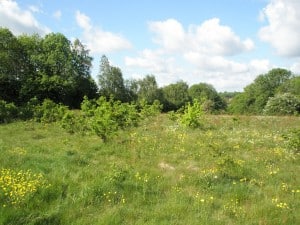Support us from £3/month
We deal with almost 1000 cases a year assisting communities, groups and individuals in protecting their local spaces and paths in all parts of England and Wales. Can you help us by joining as a member?
We are sorry to learn that the application to register the Long Field, Cranbrook, Kent, as a village green has been rejected following a public inquiry last September.
The 5.2-acre Long Field is at the junction of Angley Road (A229) and Quaker Lane on the north-east side of Cranbrook. It is crossed by two public paths and is a historic meadow, full of wild flowers and grasses.
Local people put in the application when they realised the green, which they and their predecessors had enjoyed for over 60 years, was under threat of development for a care home in 2008, and a fence was erected, preventing public use. The land is owned by Kent County Council. As it is also the body which determines greens applications, the matter was referred to an independent inspector.
The public-inquiry inspector, Mr Martin Elliott, rejected the application because he did not consider there was sufficient evidence of use by the public. Thus the field will be at risk of development.
Says Annie Oulton, a witness at the inquiry: ‘We are very sad to have lost this case. The inspector considered that there was not enough variety of use for it to qualify as a village green, the main occupation of users being dog-walking. In fact we had examples of many other activities, families play here in summer and winter, people go blackberrying, have picnics and fly kites. It was a very close call and we are considering appealing against the decision.
‘This land has been open to the community for over 60 years, ever since it fell into the hands of Kent County Council after the war. It is a haven for wildlife, on the edge of the town, and yet within easy reach of the entire neighbourhood. People using it often stop to admire the flora and fauna at different times of the year.
‘This is just the sort of application which will be prevented by the Growth and Infrastructure Bill, which is currently going through parliament and which aims to stop ‘vexatious’ applications—and yet our application was entirely genuine. The Bill will prevent applications being made on land which has a threat of planning. Yet it was not until the planning application was made that the local people, who had walked and used the land quite unconcernedly, realised that it was not safe for ever and that they needed to apply to register it as a green. Once the Bill is in force, this would not be possible.’
‘We are deeply saddened to think that this most special green space on the edge of this small community will now, inevitably, be given over to development, in line with the new government’s ethos, and a priceless piece of local topography, with intricate natural beauty, will be lost for ever.’
Adds Kate Ashbrook, our general secretary: ‘The Growth Bill will put spaces like Long Field under threat, and give local people no hope of saving it. It is a tragedy.
‘We have heard it argued in parliament that registration applications which fail must be “vexatious” and made purely to thwart development, but this application at Long Field proves that this is not so. It was a genuine application which nearly succeeded, and we commiserate with the community at their disappointment after all their hard work.’
The Long Field originally formed part of the ecclesiastical estate of Canterbury. It is marked on the tithe map of 1839 as part of the glebelands of the parish. It was sold in the latter part of the nineteenth century to a local farmer, and exchanged hands once or twice in the early part of the twentieth century before being sold to Kent County Council in 1948. It is only half the size it used to be, when it ran down to the edge of the churchyard (which is why it was called the Long Field): in the 1980s the primary school was rebuilt at the bottom end, and at the same time the rest of the field was designated ‘for educational purposes’ by Kent County Council. Until the application for a care home on the top end of the field, the field was mown once a year. However during the four-year campaign to prevent development, the council neglected the field, allowing it to fall into a poor state.

